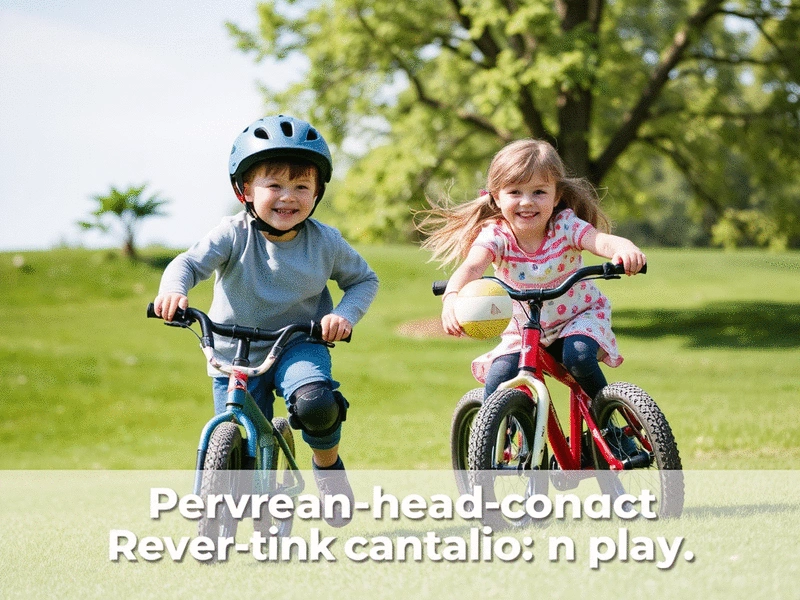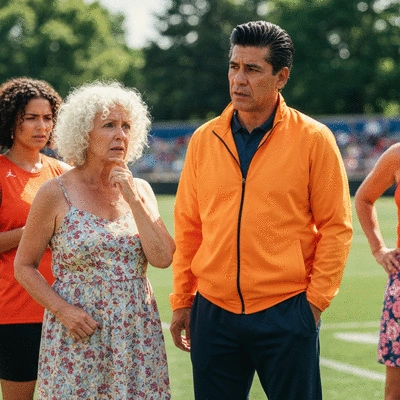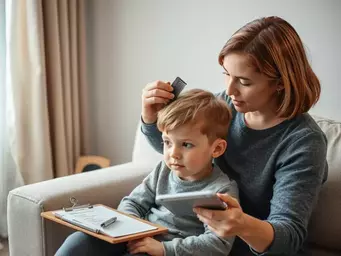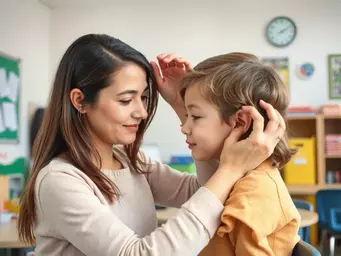Preventing Head Contact in Kids

What if the safety of your child during playtime hinged on understanding the risks they face in contact sports? Parents and coaches alike can take proactive steps to foster a safer environment for our young athletes.
What You Will Learn
- Understanding the serious risks associated with head-to-head contact can help prevent concussions in children.
- Early recognition of concussion symptoms is crucial for effective recovery.
- Implementing clear concussion policies in sports programs can significantly enhance player safety.
- Encouraging empathy and conflict resolution skills among children can reduce aggressive play and injuries.
- Utilizing tools like checklists and safety equipment can streamline injury prevention efforts during sports.
Key Injury Prevention Strategies for Child Safety
This visual outlines the crucial strategies for preventing head-to-head contact and promoting overall safety in children's activities, both in sports and beyond.
STRATEGY 1:
Concussion Policies & Resources
- Consult local health organizations for guidelines.
- Utilize templates from sports associations.
- Involve medical professionals in policy development.
STRATEGY 2:
Practical Safety Tools & Checklists
- Regular safety equipment checks before games.
- Daily warm-up & stretching routines.
- Emergency action plans for suspected injuries.
STRATEGY 3:
Community Injury Prevention Programs
- Host workshops for parents & coaches.
- Partner with schools for safe sports practices.
- Engage local businesses to sponsor safety gear.
STRATEGY 4:
Teaching Empathy & Conflict Resolution
- Incorporate team-building exercises.
- Role-play conflict resolution scenarios.
- Encourage discussions about feelings.
STRATEGY 5:
Parental Modeling of Safe Behavior
- Demonstrate safe practices during activities.
- Discuss the importance of following rules.
- Encourage open conversations about safety.
STRATEGY 6:
Behavior Management Techniques for Coaches
- Establish clear behavioral expectations.
- Provide positive reinforcement for safe play.
- Use constructive feedback for safer decisions.
STRATEGY 7:
Promoting Playground & Home Safety
- Inspect playground equipment regularly.
- Teach proper equipment usage.
- Establish ground rules for safe play at home.
STRATEGY 8:
Technology & Monitoring Tools for Safety
- Use fitness trackers for activity levels.
- Implement apps for safety info & contacts.
- Explore wearables for fall/impact detection.
STRATEGY 9:
Active Play Recommendations for Health
- Encourage outdoor activities.
- Ensure appropriate gear for all activities.
- Set boundaries for where and how to play.
Understanding the Importance of Avoiding Head-to-Head Contact in Children
When it comes to our children, their safety is always the top priority! One area that often raises concern is the risk of head-to-head contact during play and sports. Understanding this risk can help us take proactive measures to keep our little ones safe. As a health educator with a focus on child safety, I know how crucial it is to educate parents about the dangers of such contact.
Head-to-head contact can lead to serious injuries, including concussions. These injuries are not just a temporary setback; they can have long-lasting effects on a child’s health and development. It’s essential for parents and caregivers to stay informed and vigilant about these risks.

Why Head-to-Head Contact Can Be Dangerous
One of the primary reasons head-to-head contact is dangerous is due to the potential for traumatic brain injuries. When two children collide, the force can lead to concussions, which are often misdiagnosed and can lead to more severe complications. Have you noticed your child getting dizzy or confused after play? These could be signs of a concussion!
- Increased risk of brain injuries
- Potential long-term cognitive effects
- Emotional impacts, such as anxiety after an injury
It's vital to recognize that not every collision results in immediate symptoms. This delay can complicate things, making it harder for parents to identify when their child needs medical attention. For more information on predicting and preventing head injuries, you can refer to new research aiming to better predict and prevent head injuries in children.
The Role of Concussions in Child Sports Safety
As a health educator, I frequently discuss the significance of understanding concussions in youth sports. These injuries can occur in any sport where contact is a possibility. Whether it’s football, soccer, or even basketball, concussions are a real concern.
- Recognizing the symptoms early is critical for recovery.
- Implementing proper safety measures can reduce the risk of concussions.
- Education around concussion management can empower coaches and parents alike.
Being informed about how to spot a concussion and the necessary steps to take is crucial in ensuring a safe environment for our kids. The CDC's HEADS UP program offers valuable resources for concussion prevention and awareness in youth sports.
Child Safety Considerations in Contact Sports
When it comes to contact sports, child safety should always be at the forefront. Ensuring that children play in a safe environment with adequate supervision can make all the difference. Parents and coaches need to work together to create a culture of safety by discussing rules and expectations clearly.
- Ensure that all players wear proper protective gear.
- Establish and reinforce rules to minimize head-to-head contact.
- Encourage open communication about concerns related to injuries.
With these considerations in mind, we can foster a safe sports culture that prioritizes the well-being of our children. Remember, when we work together, we can make a significant impact on protecting our young athletes!
Practical Strategies for Preventing Head-to-Head Contact
Now that we understand the risks associated with head-to-head contact, let's explore some practical strategies to prevent these injuries in our children. Implementing effective techniques can significantly reduce the likelihood of such incidents occurring.
We Want to Hear From You!
What concerns do you have about head-to-head contact in children's sports? Have you experienced any situations where safety measures were particularly effective? Share your thoughts and experiences below:
Empowering Parents and Coaches: Tools for Injury Prevention
As a parent or coach, you play a crucial role in ensuring the safety of children in sports. It’s essential to equip yourself with the right tools and resources to effectively prevent injuries, particularly head-to-head contact. With my experience in pediatric care and family health, I’ve seen how knowledge can empower adults to make informed decisions that protect young athletes.
Let’s explore some practical resources that can help you develop effective concussion policies and create safer sports environments for our kids.
Resources for Developing Concussion Policies in Sports
Creating a solid concussion policy is vital for any sports program. These policies help outline the steps to take when a concussion is suspected, ensuring the health and safety of all players.
- Consult with local health organizations to access evidence-based guidelines.
- Utilize templates from established sports associations to draft your policy.
- Involve medical professionals in the development of your guidelines.
These resources not only provide clarity but also enhance the overall safety culture in your sports community. Have you implemented any concussion policies? I’d love to hear about your experiences and what worked for you!

Practical Tools and Checklists for Safe Play
To keep everyone safe, it’s essential to have practical tools and checklists handy. These can streamline your approach to injury prevention and make it easier to monitor safety during practices and games.
- Regular safety equipment checks before each game.
- Daily warm-up and stretching routines to prepare the body.
- Emergency action plans that outline steps to take during a suspected injury.
By utilizing these tools, we can foster a safer environment for our children, where they can focus on enjoying sports without the added worry of injury.
Injury Prevention Programs for Community Involvement
Community involvement is key to promoting a culture of safety in youth sports. Encouraging local organizations to develop injury prevention programs can make a significant difference in raising awareness.
- Host workshops for parents and coaches on recognizing injury symptoms.
- Create partnerships with schools to promote safe sports practices.
- Engage local businesses to sponsor safety gear for teams.
These initiatives not only educate but also create a strong support network for families, enhancing overall community awareness about sports safety.
Emphasizing Emotional and Behavioral Strategies for Safe Play
In addition to physical safety measures, we must also focus on emotional and behavioral strategies that can foster a safe and supportive environment for children during sports.
Teaching Empathy and Conflict Resolution Among Children
Instilling empathy and conflict resolution skills in children is crucial for reducing aggressive play and head-to-head contact. When kids understand and respect each other, they are less likely to engage in risky behavior.
- Incorporate team-building exercises that promote trust and communication.
- Role-play scenarios to practice conflict resolution.
- Encourage discussions about feelings and reactions after games.
These practices help children learn to navigate challenges on and off the field, promoting a more compassionate sports culture.
The Importance of Parental Modeling of Safe Behavior
As parents, we set the tone for how our children perceive safety in sports. By modeling safe behavior ourselves, we send a powerful message that prioritizing health is essential.
- Demonstrate safe practices during games and training.
- Discuss the importance of following rules and guidelines.
- Encourage open conversations about safety concerns.
Your actions speak volumes, and your children will follow your lead!
Behavior Management Techniques for Coaches
Coaches play a pivotal role in shaping young athletes’ experiences. Implementing behavior management techniques can help maintain a positive and safe environment.
- Establish clear expectations for behavior during practices and games.
- Provide positive reinforcement for safe play.
- Utilize constructive feedback to guide players toward safer decisions.
By fostering a supportive atmosphere, coaches can significantly reduce the likelihood of injuries among young athletes.
Encouraging Safe Play Beyond Sports Settings
While sports are a significant aspect of children’s lives, safe play should extend beyond the field or court. Promoting safety in all activities is crucial!
Promoting Playground Safety and Home Safety Tips
Playgrounds and home environments can also pose risks for children. It’s vital to teach safety practices that apply to all areas of their lives.
- Regularly inspect playground equipment for damage or hazards.
- Teach kids how to use equipment properly to avoid falls.
- Establish ground rules for safe play at home and in public spaces.
By encouraging safety outside of sports, we can help children develop a well-rounded understanding of how to protect themselves.
Exploring Technology and Monitoring Tools for Safety
In today’s world, technology can play a significant role in enhancing safety. Utilizing monitoring tools can help parents and coaches keep track of their children's activities and ensure their safety.
- Use fitness trackers that monitor physical activity levels.
- Implement apps that provide safety information and emergency contacts.
- Explore wearable technology that can detect falls or impacts.
These tools empower us to be proactive in safeguarding our children’s well-being.
Active Play Recommendations for Health and Safety
Encouraging active play is essential for children’s health, but it should always be done with safety in mind. Here are some recommendations for safe active play:
- Encourage outdoor activities like running, biking, or playing tag.
- Ensure children wear appropriate gear for any activity.
- Set boundaries regarding where and how children can play.
Active play promotes physical health while fostering social skills, but it’s essential to do so safely.
Summary of Key Strategies for Reducing Head-to-Head Contact
As we wrap up this section, let’s recap some key strategies that can help parents and coaches reduce head-to-head contact in children's sports.
Recap of Actionable Steps for Parents and Coaches
- Develop clear concussion policies for your sports programs.
- Utilize practical tools and checklists to ensure safe play.
- Engage in community initiatives promoting safety.
- Teach empathy and conflict resolution to children.
- Model safe behaviors as parents and coaches.
These actionable steps can make a significant impact on our children’s safety in sports and beyond!
Frequently Asked Questions (FAQs)
Q1: Why is head-to-head contact particularly dangerous for children?
A1: Head-to-head contact in children is dangerous due to the high risk of traumatic brain injuries and concussions. Children's brains are still developing and are more susceptible to injury, which can lead to long-term cognitive and emotional effects. Symptoms might also be delayed, making early detection crucial.
Q2: What are the key symptoms of a concussion in a child?
A2: Concussion symptoms can vary but commonly include dizziness, confusion, headaches, nausea, memory problems, and changes in mood or behavior. It's important to monitor children closely after any head impact, as symptoms may not appear immediately.
Q3: How can parents and coaches reduce the risk of concussions in youth sports?
A3: Parents and coaches can reduce concussion risks by implementing clear concussion policies, ensuring proper use of protective gear, establishing and enforcing rules that minimize head-to-head contact, providing education on concussion recognition, and fostering a culture of safety and fair play.
Q4: What role does empathy and conflict resolution play in preventing injuries?
A4: Teaching children empathy and conflict resolution skills can significantly reduce aggressive play and the likelihood of head-to-head contact. When children understand and respect each other, they are more likely to engage in cooperative play and less prone to reckless behavior that can lead to injuries.
Q5: Are there any technological tools available to help monitor child safety in sports?
A5: Yes, technology can assist in monitoring child safety. This includes fitness trackers to observe activity levels, apps for quick access to safety information and emergency contacts, and wearable technology designed to detect falls or impacts, providing an additional layer of protection.
Final Thoughts on the Importance of Safety in Children's Activities
At Lice Nits, we understand the importance of health and safety for our children, whether they are facing head lice or playing sports. Let’s continue to empower ourselves, our coaches, and our communities to take proactive steps toward ensuring our kids can play safely and thrive in all their activities!
Recap of Key Points
Here is a quick recap of the important points discussed in the article:
- Head-to-head contact can lead to serious injuries, including concussions, which can have long-lasting effects.
- Recognizing concussion symptoms early is critical for recovery; education around these issues is essential for parents and coaches.
- Clear concussion policies and proper protective gear are vital in contact sports to ensure child safety.
- Teaching empathy and conflict resolution can reduce aggressive play and enhance a supportive sports culture.
- Community involvement in safety initiatives can significantly raise awareness and promote safer sports environments.
Popular Posts
 Have you ever felt the panic that arises when you discover head lice on your child's scalp? Understa
Have you ever felt the panic that arises when you discover head lice on your child's scalp? Understa
 It's surprising how easily something as small as a head louse can disrupt an entire school community
It's surprising how easily something as small as a head louse can disrupt an entire school community
 What if the key to your child's comfort and well-being lies in understanding the aftercare process f
What if the key to your child's comfort and well-being lies in understanding the aftercare process f
 What if a single application could free your family from the stress of head lice? One-dose treatment
What if a single application could free your family from the stress of head lice? One-dose treatment
